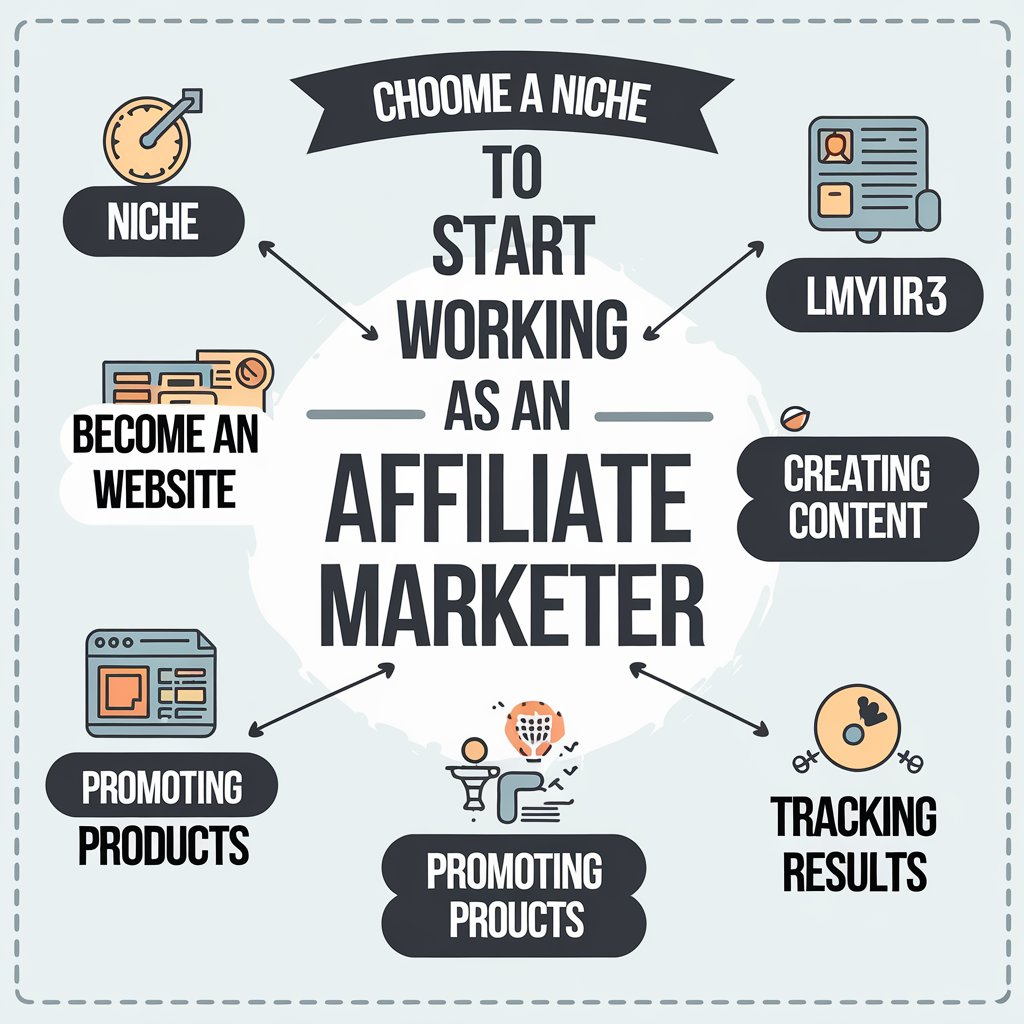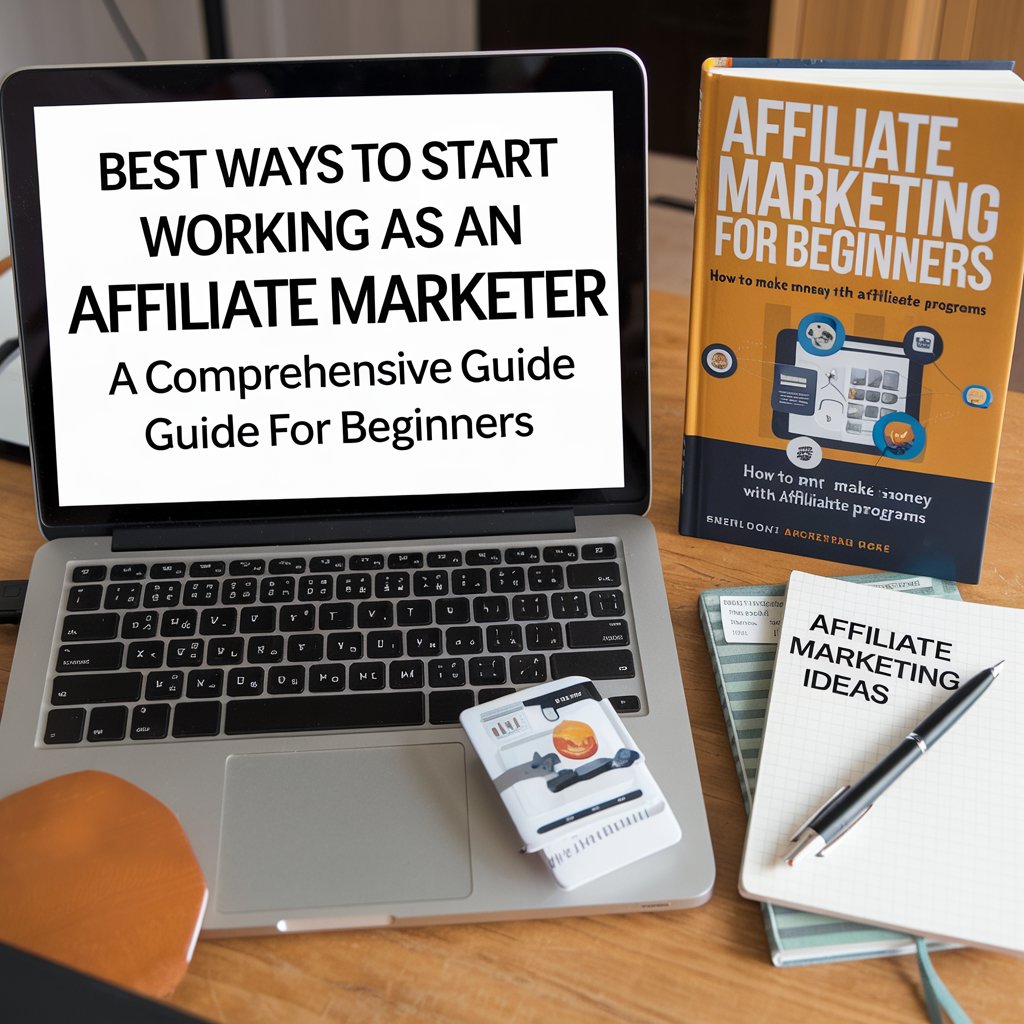
- Affiliate marketing has become one of the most popular ways to make money online, thanks to its low startup costs and flexible nature. As an affiliate marketer, you earn commissions by promoting other people’s products or services through your website, blog, social media, or other digital platforms. The idea is simple, but succeeding as an affiliate marketer takes strategy, patience, and a consistent effort. This comprehensive guide will walk you through the best ways to start working as an affiliate marketer and set yourself up for long-term success.
1. Understand the Basics of Affiliate Marketing
- Before diving into affiliate marketing, it’s important to understand the fundamentals. Affiliate marketing is a performance-based model where you earn a commission for every sale or action (such as a lead or click) that occurs through your unique affiliate link. There are typically three parties involved:
Merchant (Advertiser): The person or company that owns the product or service.
Affiliate (Publisher): You, the marketer who promotes the product or service.
Customer: The person who buys or acts on the merchant’s product through your link.
The process usually works as follows:
- You sign up for an affiliate program or affiliate network.
- You get a unique referral link.
- You share that link through your content, such as blog posts, social media, or emails.
- When a user clicks on your link and makes a purchase, you earn a commission.
2. Choose a Niche You’re Passionate About
- One of the first steps to becoming a successful affiliate marketer is choosing a niche that you are passionate about or have expertise in. A niche is a specific market segment or audience with particular interests. Picking a niche helps you create focused content that resonates with your target audience, making it easier to convert readers into buyers.
Popular Affiliate Marketing Niches:
Health & Wellness: Products like supplements, fitness equipment, and health apps.
Personal Finance: Credit cards, loans, and investment platforms.
Tech & Gadgets: Reviews and promotions of the latest gadgets, software, or apps.
Beauty & Fashion: Makeup, skincare, and fashion products.
Travel: Hotels, flights, travel gear, and experiences.
Online Education: Courses, eBooks, and certifications.
- When selecting a niche, consider your interests, the profitability of the niche, and the competition level. Opt for a niche where you can provide genuine value, engage with your audience, and position yourself as a knowledgeable source.
3. Research and Join Affiliate Programs
- After selecting your niche, the next step is to find affiliate programs that match your niche and audience. There are two primary types of affiliate programs:
Affiliate Networks: These are platforms that connect affiliates with multiple merchants. Examples include Amazon Associates, CJ Affiliate, ShareASale, and Rakuten. They offer a variety of products across multiple industries.
Direct Affiliate Programs: Some companies run their own affiliate programs, such as Shopify, Bluehost, or ClickFunnels. These tend to offer higher commissions but are often more specific to their products or services.
- When researching affiliate programs, consider the following:
Commission Rates: How much will you earn per sale or lead? Typically, digital products offer higher commissions (20%-50%) than physical products (3%-10%).
Cookie Duration: Cookies track when someone clicks on your affiliate link. A longer cookie duration (e.g., 30-90 days) increases your chances of earning a commission, even if the customer doesn’t buy immediately.
Reputation and Support: Join reputable programs that offer clear communication, reliable tracking, and good customer support.
4. Build a Platform for Your Content
- To start making money with affiliate marketing, you’ll need a platform where you can promote products and services. Most affiliate marketers use websites, blogs, or social media channels to share their content
Options for Affiliate Marketing Platforms:
Blog or Website: A blog or website is often the best long-term platform for affiliate marketing. It gives you complete control over your content and allows you to build a loyal audience. You can use platforms like WordPress, Wix, or Squarespace to create your site.
Content Ideas: Write product reviews, comparisons, how-to guides, and tutorials related to your niche. For example, if you are in the health niche, create blog posts like “Best Protein Supplements for Muscle Gain” or “How to Create a Home Gym on a Budget” with affiliate links to products.
YouTube Channel: Video content is one of the fastest-growing ways to reach audiences. You can create video tutorials, product unboxings, and reviews. Add your affiliate links in the description box below your videos.
Content Ideas: Review products on camera, explain how they work, and share your personal experience. This gives you the opportunity to promote affiliate products naturally.
Social Media: Platforms like Instagram, Pinterest, and TikTok allow you to share affiliate links in your posts, stories, and bio. Social media is particularly effective for influencers or those with an engaged following.
Content Ideas: Post photos or videos showcasing the products you’re promoting, and offer tips on how your audience can benefit from them.
Email Marketing: Building an email list is another effective way to promote affiliate products. Offer a lead magnet (such as a free guide or eBook) in exchange for email sign-ups, and use regular newsletters to share affiliate product recommendations.
5. Create Valuable Content
- In affiliate marketing, content is king. Your content is what attracts visitors, builds trust, and ultimately drives conversions. The key to success is to create valuable, high-quality content that genuinely helps your audience solve problems or make informed decisions.
Types of Affiliate Marketing Content:
Product Reviews: Write detailed reviews of the products you are promoting. Be honest and transparent, highlighting both the pros and cons. Include your affiliate link within the review so readers can make a purchase.
How-To Guides: Create step-by-step guides that teach your audience how to use the products you’re promoting. For example, if you’re in the tech niche, you could write a guide on “How to Set Up a Home Office with the Best Gadgets and Tools.”
Top 10 Lists: People love curated lists of the best products. Write articles like “Top 10 Running Shoes for Beginners” or “Best Travel Gadgets for 2024” and include affiliate links to each item.
Tutorials and Demonstrations: Demonstrate how a product works through videos or blog posts. This is especially useful for products that require some setup or use, like tech gadgets or software.
Comparisons: Comparing two or more products in your niche helps users decide which one is best for them. For example, you could write a comparison post on “Bluehost vs. SiteGround: Which Hosting is Better for New Bloggers?”
6. Focus on SEO (Search Engine Optimization)
- To succeed in affiliate marketing, you need traffic—and one of the best ways to get traffic is through SEO (Search Engine Optimization). SEO is the practice of optimizing your website or content so it ranks higher in search engines like Google
Key SEO Tips for Affiliate Marketing:
Keyword Research: Find relevant keywords that your audience is searching for. Use tools like Google Keyword Planner, Ahrefs, or SEMRush to identify keywords with good search volume and low competition. Target long-tail keywords (e.g., “best running shoes for flat feet”) for better ranking opportunities.
Optimize Content: Use your target keywords in strategic places such as your title, headings, meta description, and throughout the body of your content. However, avoid keyword stuffing—focus on creating natural, valuable content.
Build Backlinks: Backlinks from reputable websites signal to search engines that your content is valuable. You can build backlinks by guest blogging, collaborating with other bloggers, and promoting your content.
Create Valuable Content: SEO isn’t just about keywords. Google also prioritizes high-quality content that satisfies user intent. Make sure your content is informative, easy to read, and answers the questions your audience is searching for.
7. Promote Your Content and Build an Audience
- Once you’ve created your platform and content, the next step is promoting it to reach a wider audience. There are several effective ways to drive traffic to your affiliate marketing content:
Strategies for Promoting Your Content:
Social Media Marketing: Share your blog posts, videos, and product reviews on social media platforms like Facebook, Instagram, Pinterest, and Twitter. Use relevant hashtags and engage with your followers.
Email Marketing: Build an email list and send regular newsletters promoting your latest affiliate products and content. Offer value in your emails by providing tips, tutorials, or exclusive discounts.
Paid Advertising: Consider using paid ads on platforms like Google Ads, Facebook Ads, or Pinterest Ads to promote your affiliate content. Paid advertising can help you reach a wider audience quickly, though it requires an upfront investment.
Collaborate with Influencers: Partnering with influencers or bloggers in your niche can help you reach their audience. Collaborations could include guest posts, social media takeovers, or joint product reviews.
8. Track Your Performance and Optimize
- The best affiliate marketers continuously track their performance to see what’s working and what’s not. Most affiliate programs provide detailed analytics showing your clicks, conversions, and earnings. Use this data to fine-tune your approach and improve your results over time.
Tips for Optimizing Your Affiliate Marketing Strategy:
Test Different Content Types: Experiment with different types of content to see what resonates with your audience. For example, you might find that product reviews perform better than comparison posts or that video tutorials drive more traffic than blog articles.
Optimize Conversion Rates: Small tweaks can significantly improve your conversion rates. Test different call-to-action (CTA) buttons, images, or affiliate link placements to see what leads to more clicks and purchases.
Update Old Content: As products evolve or new products come to market, update your old content to ensure it remains relevant. Updated content can improve your SEO rankings and keep your audience engaged.
9. Stay Patient and Consistent
- Affiliate marketing is not a get-rich-quick scheme. It takes time to build an audience, create valuable content, and see consistent earnings. The key to success is patience, consistency, and continuous learning. As you grow your platform and refine your strategies, you’ll start to see more traffic, higher conversion rates, and increased earnings over time.
Conclusion
- By following these steps, you’ll be well on your way to starting a successful career in affiliate marketing. Whether you’re looking for a side income or want to turn affiliate marketing into a full-time business, the right strategy, dedication, and persistence will help you achieve your financial goals.










